Volunteering Attitudes Among Nursing Students: Impact on Pedagogy
VerifiedAdded on 2023/06/05
|39
|9146
|52
Report
AI Summary
This report investigates the extent, variability, and attitudes towards volunteering among undergraduate nursing students and its implications for pedagogy in nursing and midwifery education. The study addresses the need for critical thinking skills in nurses within the National Health Service (NHS) and explores volunteering as a strategy for developing these skills. It examines the benefits of volunteering for nursing students, including increased social exposure, self-confidence, and critical perspectives. The report also discusses the role of care and compassion in the nursing curriculum and suggests that structured voluntary activities can enhance student learning and understanding of compassionate nursing practice. The research highlights the potential of volunteering to foster compassion and critical thinking skills, contributing to a more comprehensive nursing education.
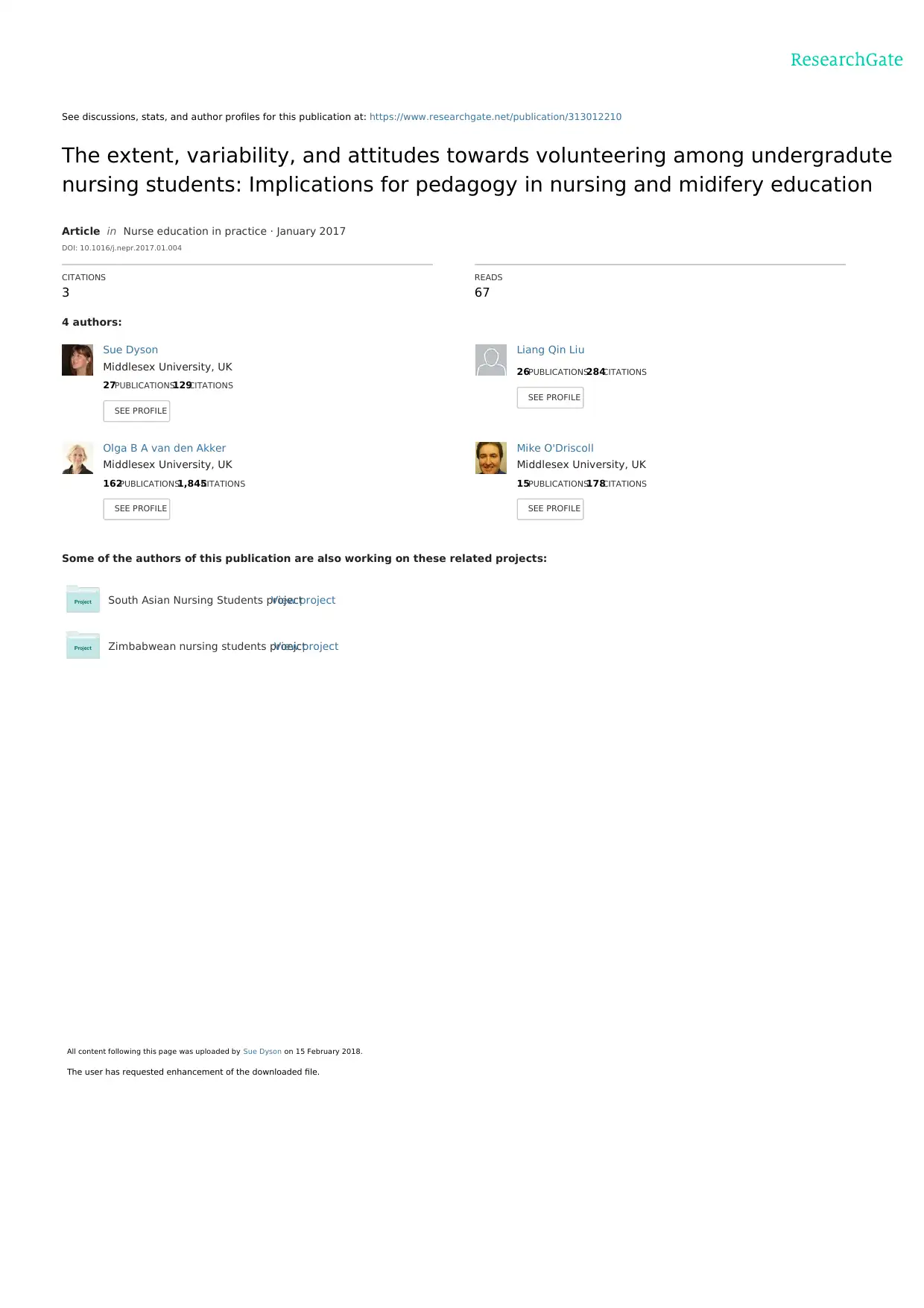
See discussions, stats, and author profiles for this publication at: https://www.researchgate.net/publication/313012210
The extent, variability, and attitudes towards volunteering among undergradute
nursing students: Implications for pedagogy in nursing and midifery education
Article in Nurse education in practice · January 2017
DOI: 10.1016/j.nepr.2017.01.004
CITATIONS
3
READS
67
4 authors:
Some of the authors of this publication are also working on these related projects:
South Asian Nursing Students projectView project
Zimbabwean nursing students proejctView project
Sue Dyson
Middlesex University, UK
27PUBLICATIONS129CITATIONS
SEE PROFILE
Liang Qin Liu
26PUBLICATIONS284CITATIONS
SEE PROFILE
Olga B A van den Akker
Middlesex University, UK
162PUBLICATIONS1,845CITATIONS
SEE PROFILE
Mike O'Driscoll
Middlesex University, UK
15PUBLICATIONS178CITATIONS
SEE PROFILE
All content following this page was uploaded by Sue Dyson on 15 February 2018.
The user has requested enhancement of the downloaded file.
The extent, variability, and attitudes towards volunteering among undergradute
nursing students: Implications for pedagogy in nursing and midifery education
Article in Nurse education in practice · January 2017
DOI: 10.1016/j.nepr.2017.01.004
CITATIONS
3
READS
67
4 authors:
Some of the authors of this publication are also working on these related projects:
South Asian Nursing Students projectView project
Zimbabwean nursing students proejctView project
Sue Dyson
Middlesex University, UK
27PUBLICATIONS129CITATIONS
SEE PROFILE
Liang Qin Liu
26PUBLICATIONS284CITATIONS
SEE PROFILE
Olga B A van den Akker
Middlesex University, UK
162PUBLICATIONS1,845CITATIONS
SEE PROFILE
Mike O'Driscoll
Middlesex University, UK
15PUBLICATIONS178CITATIONS
SEE PROFILE
All content following this page was uploaded by Sue Dyson on 15 February 2018.
The user has requested enhancement of the downloaded file.
Paraphrase This Document
Need a fresh take? Get an instant paraphrase of this document with our AI Paraphraser
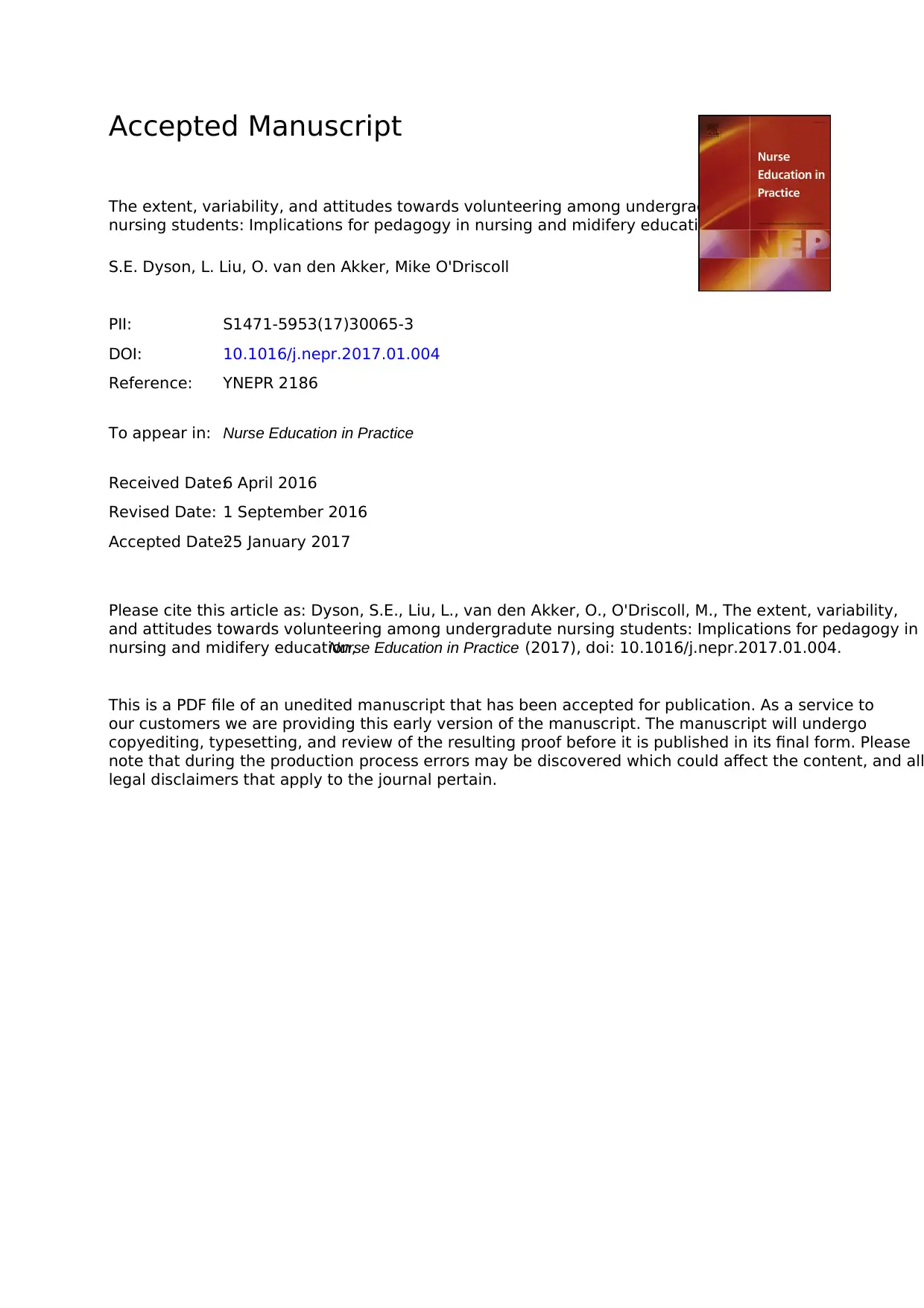
Accepted Manuscript
The extent, variability, and attitudes towards volunteering among undergradute
nursing students: Implications for pedagogy in nursing and midifery education
S.E. Dyson, L. Liu, O. van den Akker, Mike O'Driscoll
PII: S1471-5953(17)30065-3
DOI: 10.1016/j.nepr.2017.01.004
Reference: YNEPR 2186
To appear in: Nurse Education in Practice
Received Date:6 April 2016
Revised Date: 1 September 2016
Accepted Date:25 January 2017
Please cite this article as: Dyson, S.E., Liu, L., van den Akker, O., O'Driscoll, M., The extent, variability,
and attitudes towards volunteering among undergradute nursing students: Implications for pedagogy in
nursing and midifery education,Nurse Education in Practice (2017), doi: 10.1016/j.nepr.2017.01.004.
This is a PDF file of an unedited manuscript that has been accepted for publication. As a service to
our customers we are providing this early version of the manuscript. The manuscript will undergo
copyediting, typesetting, and review of the resulting proof before it is published in its final form. Please
note that during the production process errors may be discovered which could affect the content, and all
legal disclaimers that apply to the journal pertain.
The extent, variability, and attitudes towards volunteering among undergradute
nursing students: Implications for pedagogy in nursing and midifery education
S.E. Dyson, L. Liu, O. van den Akker, Mike O'Driscoll
PII: S1471-5953(17)30065-3
DOI: 10.1016/j.nepr.2017.01.004
Reference: YNEPR 2186
To appear in: Nurse Education in Practice
Received Date:6 April 2016
Revised Date: 1 September 2016
Accepted Date:25 January 2017
Please cite this article as: Dyson, S.E., Liu, L., van den Akker, O., O'Driscoll, M., The extent, variability,
and attitudes towards volunteering among undergradute nursing students: Implications for pedagogy in
nursing and midifery education,Nurse Education in Practice (2017), doi: 10.1016/j.nepr.2017.01.004.
This is a PDF file of an unedited manuscript that has been accepted for publication. As a service to
our customers we are providing this early version of the manuscript. The manuscript will undergo
copyediting, typesetting, and review of the resulting proof before it is published in its final form. Please
note that during the production process errors may be discovered which could affect the content, and all
legal disclaimers that apply to the journal pertain.
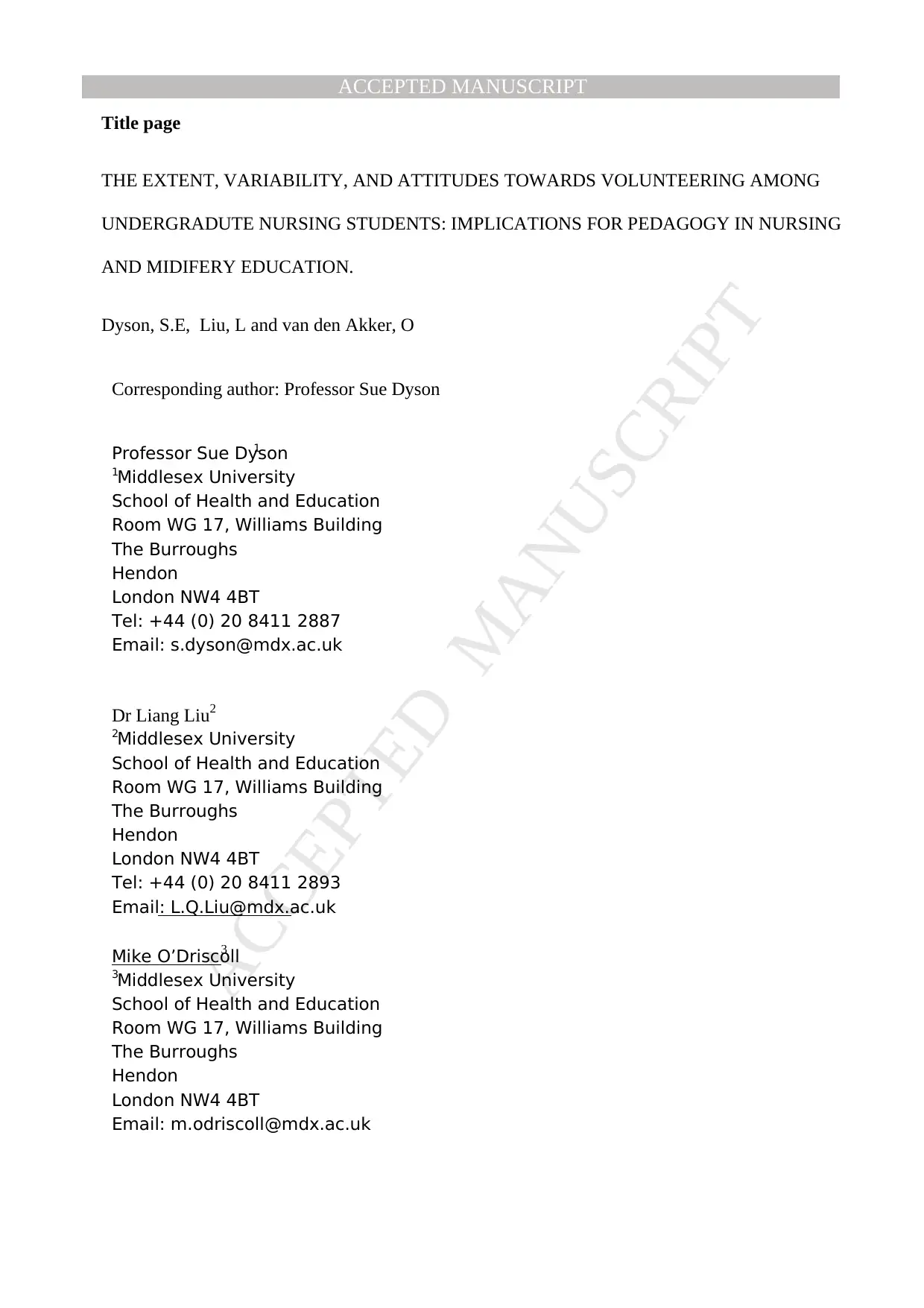
MANUSCRIPTACCEPTED
ACCEPTED MANUSCRIPT
Title page
THE EXTENT, VARIABILITY, AND ATTITUDES TOWARDS VOLUNTEERING AMONG
UNDERGRADUTE NURSING STUDENTS: IMPLICATIONS FOR PEDAGOGY IN NURSING
AND MIDIFERY EDUCATION.
Dyson, S.E, Liu, L and van den Akker, O
Corresponding author: Professor Sue Dyson
Professor Sue Dyson1
1Middlesex University
School of Health and Education
Room WG 17, Williams Building
The Burroughs
Hendon
London NW4 4BT
Tel: +44 (0) 20 8411 2887
Email: s.dyson@mdx.ac.uk
Dr Liang Liu2
2Middlesex University
School of Health and Education
Room WG 17, Williams Building
The Burroughs
Hendon
London NW4 4BT
Tel: +44 (0) 20 8411 2893
Email: L.Q.Liu@mdx.ac.uk
Mike O’Driscoll3
3Middlesex University
School of Health and Education
Room WG 17, Williams Building
The Burroughs
Hendon
London NW4 4BT
Email: m.odriscoll@mdx.ac.uk
ACCEPTED MANUSCRIPT
Title page
THE EXTENT, VARIABILITY, AND ATTITUDES TOWARDS VOLUNTEERING AMONG
UNDERGRADUTE NURSING STUDENTS: IMPLICATIONS FOR PEDAGOGY IN NURSING
AND MIDIFERY EDUCATION.
Dyson, S.E, Liu, L and van den Akker, O
Corresponding author: Professor Sue Dyson
Professor Sue Dyson1
1Middlesex University
School of Health and Education
Room WG 17, Williams Building
The Burroughs
Hendon
London NW4 4BT
Tel: +44 (0) 20 8411 2887
Email: s.dyson@mdx.ac.uk
Dr Liang Liu2
2Middlesex University
School of Health and Education
Room WG 17, Williams Building
The Burroughs
Hendon
London NW4 4BT
Tel: +44 (0) 20 8411 2893
Email: L.Q.Liu@mdx.ac.uk
Mike O’Driscoll3
3Middlesex University
School of Health and Education
Room WG 17, Williams Building
The Burroughs
Hendon
London NW4 4BT
Email: m.odriscoll@mdx.ac.uk
⊘ This is a preview!⊘
Do you want full access?
Subscribe today to unlock all pages.

Trusted by 1+ million students worldwide
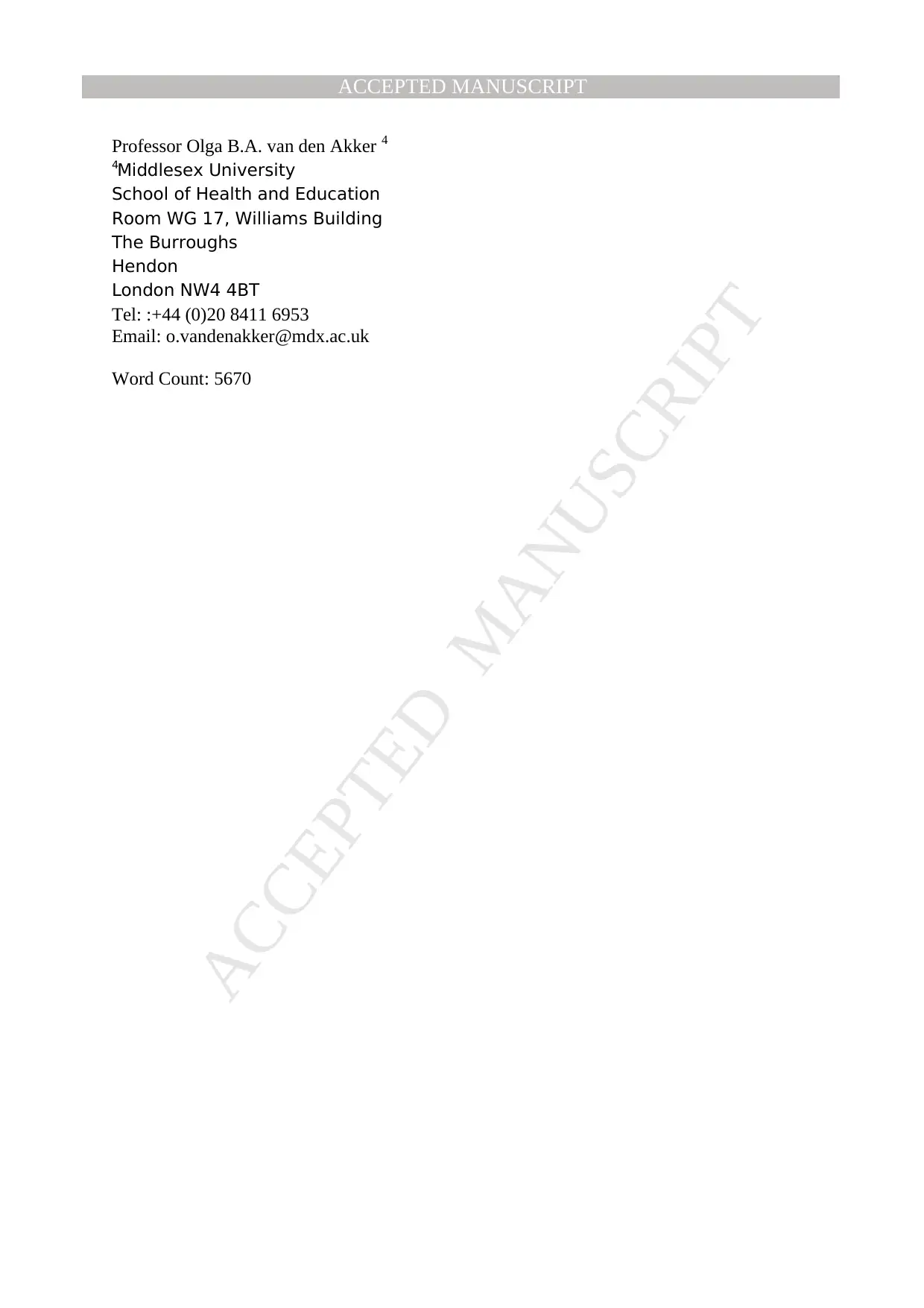
MANUSCRIPTACCEPTED
ACCEPTED MANUSCRIPT
Professor Olga B.A. van den Akker 4
4Middlesex University
School of Health and Education
Room WG 17, Williams Building
The Burroughs
Hendon
London NW4 4BT
Tel: :+44 (0)20 8411 6953
Email: o.vandenakker@mdx.ac.uk
Word Count: 5670
ACCEPTED MANUSCRIPT
Professor Olga B.A. van den Akker 4
4Middlesex University
School of Health and Education
Room WG 17, Williams Building
The Burroughs
Hendon
London NW4 4BT
Tel: :+44 (0)20 8411 6953
Email: o.vandenakker@mdx.ac.uk
Word Count: 5670
Paraphrase This Document
Need a fresh take? Get an instant paraphrase of this document with our AI Paraphraser
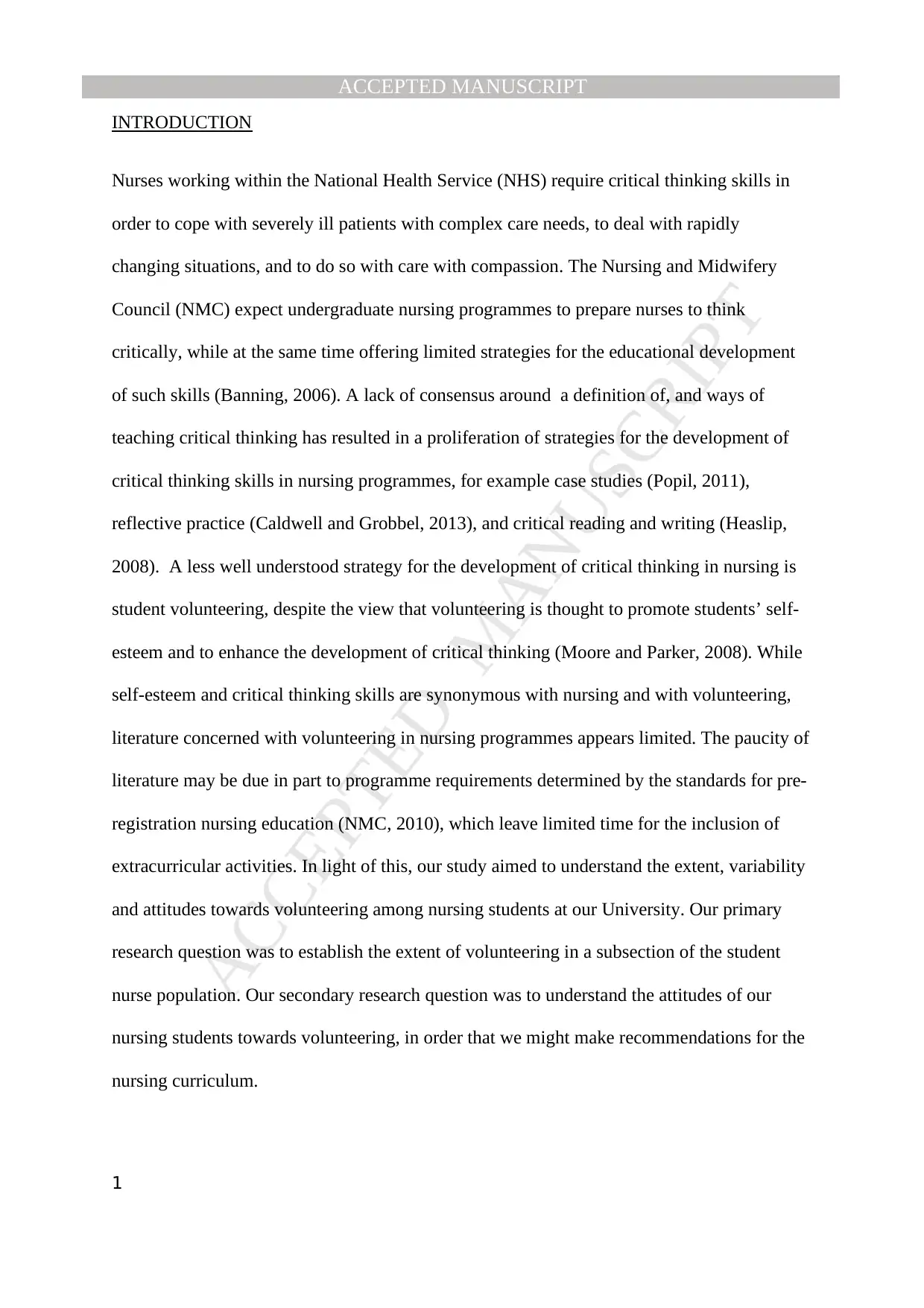
MANUSCRIPTACCEPTED
ACCEPTED MANUSCRIPT
1
INTRODUCTION
Nurses working within the National Health Service (NHS) require critical thinking skills in
order to cope with severely ill patients with complex care needs, to deal with rapidly
changing situations, and to do so with care with compassion. The Nursing and Midwifery
Council (NMC) expect undergraduate nursing programmes to prepare nurses to think
critically, while at the same time offering limited strategies for the educational development
of such skills (Banning, 2006). A lack of consensus around a definition of, and ways of
teaching critical thinking has resulted in a proliferation of strategies for the development of
critical thinking skills in nursing programmes, for example case studies (Popil, 2011),
reflective practice (Caldwell and Grobbel, 2013), and critical reading and writing (Heaslip,
2008). A less well understood strategy for the development of critical thinking in nursing is
student volunteering, despite the view that volunteering is thought to promote students’ self-
esteem and to enhance the development of critical thinking (Moore and Parker, 2008). While
self-esteem and critical thinking skills are synonymous with nursing and with volunteering,
literature concerned with volunteering in nursing programmes appears limited. The paucity of
literature may be due in part to programme requirements determined by the standards for pre-
registration nursing education (NMC, 2010), which leave limited time for the inclusion of
extracurricular activities. In light of this, our study aimed to understand the extent, variability
and attitudes towards volunteering among nursing students at our University. Our primary
research question was to establish the extent of volunteering in a subsection of the student
nurse population. Our secondary research question was to understand the attitudes of our
nursing students towards volunteering, in order that we might make recommendations for the
nursing curriculum.
ACCEPTED MANUSCRIPT
1
INTRODUCTION
Nurses working within the National Health Service (NHS) require critical thinking skills in
order to cope with severely ill patients with complex care needs, to deal with rapidly
changing situations, and to do so with care with compassion. The Nursing and Midwifery
Council (NMC) expect undergraduate nursing programmes to prepare nurses to think
critically, while at the same time offering limited strategies for the educational development
of such skills (Banning, 2006). A lack of consensus around a definition of, and ways of
teaching critical thinking has resulted in a proliferation of strategies for the development of
critical thinking skills in nursing programmes, for example case studies (Popil, 2011),
reflective practice (Caldwell and Grobbel, 2013), and critical reading and writing (Heaslip,
2008). A less well understood strategy for the development of critical thinking in nursing is
student volunteering, despite the view that volunteering is thought to promote students’ self-
esteem and to enhance the development of critical thinking (Moore and Parker, 2008). While
self-esteem and critical thinking skills are synonymous with nursing and with volunteering,
literature concerned with volunteering in nursing programmes appears limited. The paucity of
literature may be due in part to programme requirements determined by the standards for pre-
registration nursing education (NMC, 2010), which leave limited time for the inclusion of
extracurricular activities. In light of this, our study aimed to understand the extent, variability
and attitudes towards volunteering among nursing students at our University. Our primary
research question was to establish the extent of volunteering in a subsection of the student
nurse population. Our secondary research question was to understand the attitudes of our
nursing students towards volunteering, in order that we might make recommendations for the
nursing curriculum.
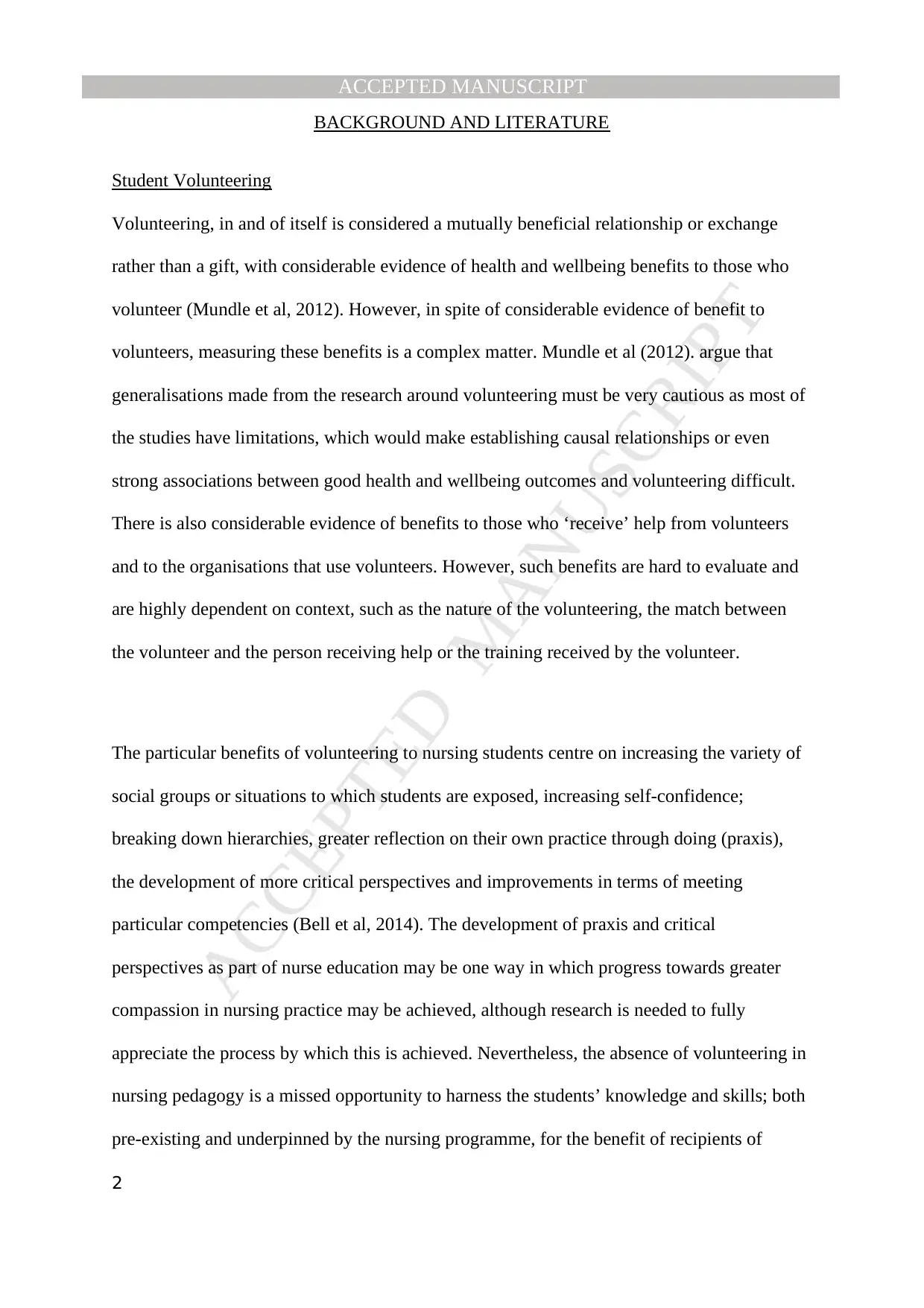
MANUSCRIPTACCEPTED
ACCEPTED MANUSCRIPT
2
BACKGROUND AND LITERATURE
Student Volunteering
Volunteering, in and of itself is considered a mutually beneficial relationship or exchange
rather than a gift, with considerable evidence of health and wellbeing benefits to those who
volunteer (Mundle et al, 2012). However, in spite of considerable evidence of benefit to
volunteers, measuring these benefits is a complex matter. Mundle et al (2012). argue that
generalisations made from the research around volunteering must be very cautious as most of
the studies have limitations, which would make establishing causal relationships or even
strong associations between good health and wellbeing outcomes and volunteering difficult.
There is also considerable evidence of benefits to those who ‘receive’ help from volunteers
and to the organisations that use volunteers. However, such benefits are hard to evaluate and
are highly dependent on context, such as the nature of the volunteering, the match between
the volunteer and the person receiving help or the training received by the volunteer.
The particular benefits of volunteering to nursing students centre on increasing the variety of
social groups or situations to which students are exposed, increasing self-confidence;
breaking down hierarchies, greater reflection on their own practice through doing (praxis),
the development of more critical perspectives and improvements in terms of meeting
particular competencies (Bell et al, 2014). The development of praxis and critical
perspectives as part of nurse education may be one way in which progress towards greater
compassion in nursing practice may be achieved, although research is needed to fully
appreciate the process by which this is achieved. Nevertheless, the absence of volunteering in
nursing pedagogy is a missed opportunity to harness the students’ knowledge and skills; both
pre-existing and underpinned by the nursing programme, for the benefit of recipients of
ACCEPTED MANUSCRIPT
2
BACKGROUND AND LITERATURE
Student Volunteering
Volunteering, in and of itself is considered a mutually beneficial relationship or exchange
rather than a gift, with considerable evidence of health and wellbeing benefits to those who
volunteer (Mundle et al, 2012). However, in spite of considerable evidence of benefit to
volunteers, measuring these benefits is a complex matter. Mundle et al (2012). argue that
generalisations made from the research around volunteering must be very cautious as most of
the studies have limitations, which would make establishing causal relationships or even
strong associations between good health and wellbeing outcomes and volunteering difficult.
There is also considerable evidence of benefits to those who ‘receive’ help from volunteers
and to the organisations that use volunteers. However, such benefits are hard to evaluate and
are highly dependent on context, such as the nature of the volunteering, the match between
the volunteer and the person receiving help or the training received by the volunteer.
The particular benefits of volunteering to nursing students centre on increasing the variety of
social groups or situations to which students are exposed, increasing self-confidence;
breaking down hierarchies, greater reflection on their own practice through doing (praxis),
the development of more critical perspectives and improvements in terms of meeting
particular competencies (Bell et al, 2014). The development of praxis and critical
perspectives as part of nurse education may be one way in which progress towards greater
compassion in nursing practice may be achieved, although research is needed to fully
appreciate the process by which this is achieved. Nevertheless, the absence of volunteering in
nursing pedagogy is a missed opportunity to harness the students’ knowledge and skills; both
pre-existing and underpinned by the nursing programme, for the benefit of recipients of
⊘ This is a preview!⊘
Do you want full access?
Subscribe today to unlock all pages.

Trusted by 1+ million students worldwide
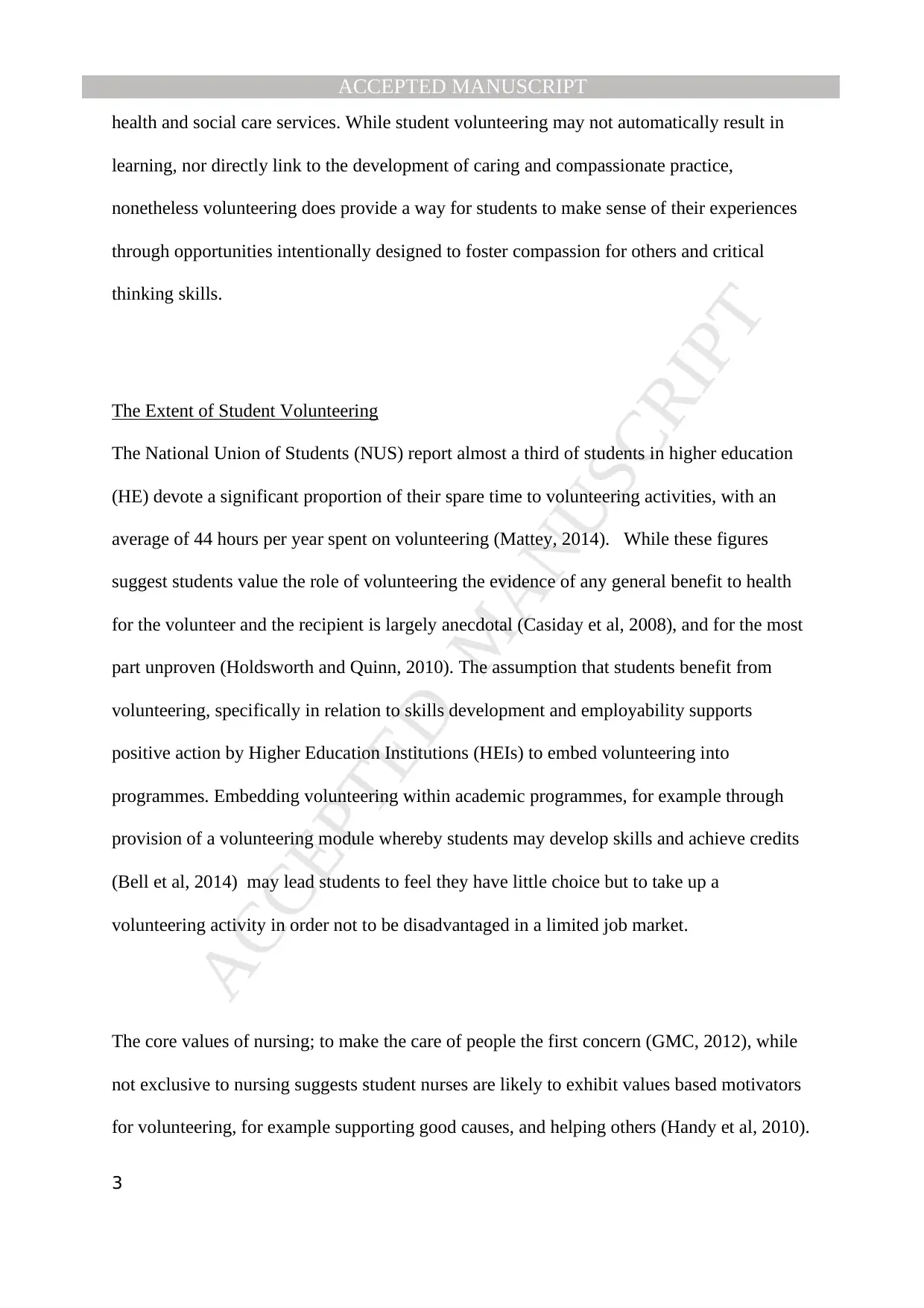
MANUSCRIPTACCEPTED
ACCEPTED MANUSCRIPT
3
health and social care services. While student volunteering may not automatically result in
learning, nor directly link to the development of caring and compassionate practice,
nonetheless volunteering does provide a way for students to make sense of their experiences
through opportunities intentionally designed to foster compassion for others and critical
thinking skills.
The Extent of Student Volunteering
The National Union of Students (NUS) report almost a third of students in higher education
(HE) devote a significant proportion of their spare time to volunteering activities, with an
average of 44 hours per year spent on volunteering (Mattey, 2014). While these figures
suggest students value the role of volunteering the evidence of any general benefit to health
for the volunteer and the recipient is largely anecdotal (Casiday et al, 2008), and for the most
part unproven (Holdsworth and Quinn, 2010). The assumption that students benefit from
volunteering, specifically in relation to skills development and employability supports
positive action by Higher Education Institutions (HEIs) to embed volunteering into
programmes. Embedding volunteering within academic programmes, for example through
provision of a volunteering module whereby students may develop skills and achieve credits
(Bell et al, 2014) may lead students to feel they have little choice but to take up a
volunteering activity in order not to be disadvantaged in a limited job market.
The core values of nursing; to make the care of people the first concern (GMC, 2012), while
not exclusive to nursing suggests student nurses are likely to exhibit values based motivators
for volunteering, for example supporting good causes, and helping others (Handy et al, 2010).
ACCEPTED MANUSCRIPT
3
health and social care services. While student volunteering may not automatically result in
learning, nor directly link to the development of caring and compassionate practice,
nonetheless volunteering does provide a way for students to make sense of their experiences
through opportunities intentionally designed to foster compassion for others and critical
thinking skills.
The Extent of Student Volunteering
The National Union of Students (NUS) report almost a third of students in higher education
(HE) devote a significant proportion of their spare time to volunteering activities, with an
average of 44 hours per year spent on volunteering (Mattey, 2014). While these figures
suggest students value the role of volunteering the evidence of any general benefit to health
for the volunteer and the recipient is largely anecdotal (Casiday et al, 2008), and for the most
part unproven (Holdsworth and Quinn, 2010). The assumption that students benefit from
volunteering, specifically in relation to skills development and employability supports
positive action by Higher Education Institutions (HEIs) to embed volunteering into
programmes. Embedding volunteering within academic programmes, for example through
provision of a volunteering module whereby students may develop skills and achieve credits
(Bell et al, 2014) may lead students to feel they have little choice but to take up a
volunteering activity in order not to be disadvantaged in a limited job market.
The core values of nursing; to make the care of people the first concern (GMC, 2012), while
not exclusive to nursing suggests student nurses are likely to exhibit values based motivators
for volunteering, for example supporting good causes, and helping others (Handy et al, 2010).
Paraphrase This Document
Need a fresh take? Get an instant paraphrase of this document with our AI Paraphraser
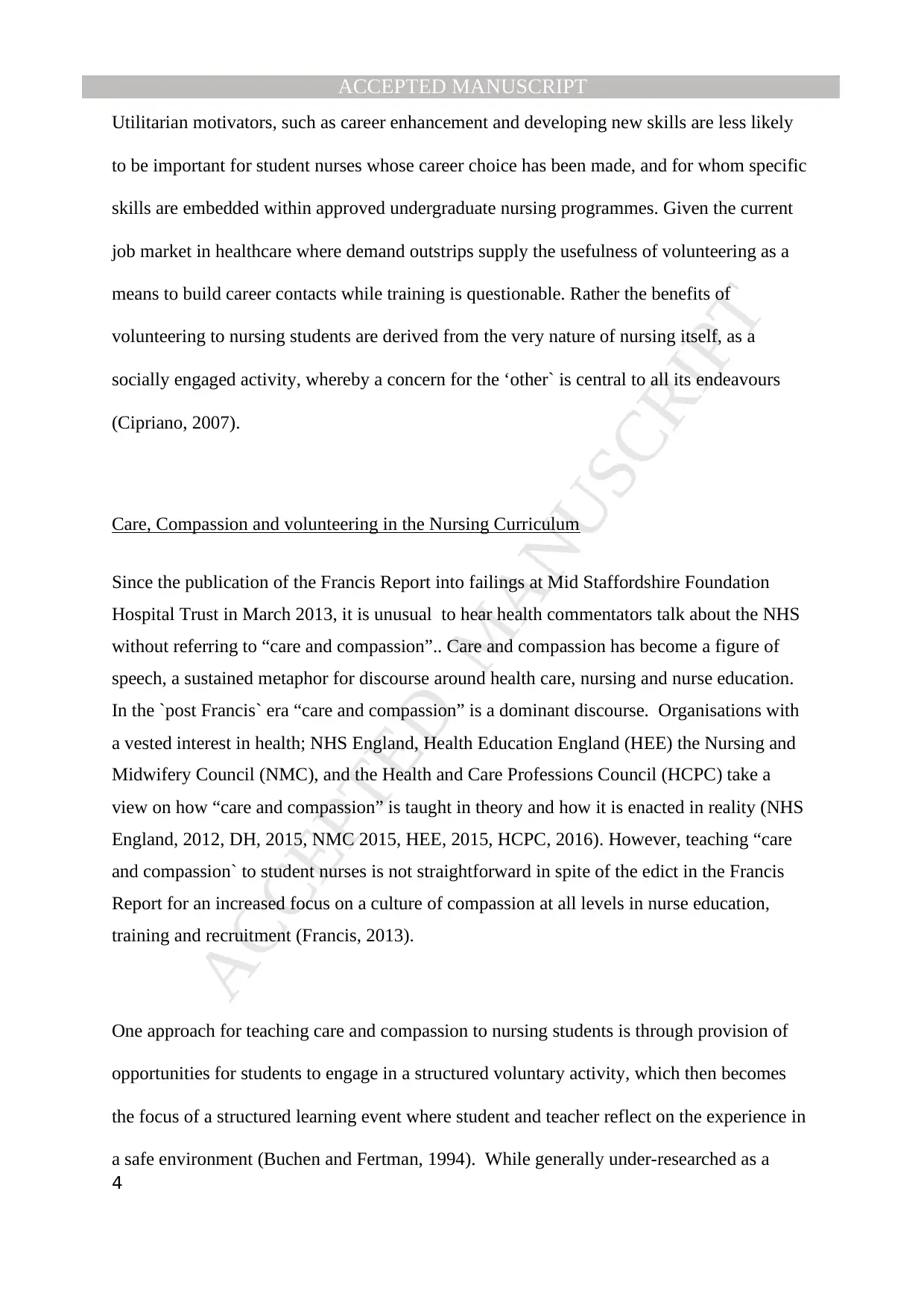
MANUSCRIPTACCEPTED
ACCEPTED MANUSCRIPT
4
Utilitarian motivators, such as career enhancement and developing new skills are less likely
to be important for student nurses whose career choice has been made, and for whom specific
skills are embedded within approved undergraduate nursing programmes. Given the current
job market in healthcare where demand outstrips supply the usefulness of volunteering as a
means to build career contacts while training is questionable. Rather the benefits of
volunteering to nursing students are derived from the very nature of nursing itself, as a
socially engaged activity, whereby a concern for the ‘other` is central to all its endeavours
(Cipriano, 2007).
Care, Compassion and volunteering in the Nursing Curriculum
Since the publication of the Francis Report into failings at Mid Staffordshire Foundation
Hospital Trust in March 2013, it is unusual to hear health commentators talk about the NHS
without referring to “care and compassion”.. Care and compassion has become a figure of
speech, a sustained metaphor for discourse around health care, nursing and nurse education.
In the `post Francis` era “care and compassion” is a dominant discourse. Organisations with
a vested interest in health; NHS England, Health Education England (HEE) the Nursing and
Midwifery Council (NMC), and the Health and Care Professions Council (HCPC) take a
view on how “care and compassion” is taught in theory and how it is enacted in reality (NHS
England, 2012, DH, 2015, NMC 2015, HEE, 2015, HCPC, 2016). However, teaching “care
and compassion` to student nurses is not straightforward in spite of the edict in the Francis
Report for an increased focus on a culture of compassion at all levels in nurse education,
training and recruitment (Francis, 2013).
One approach for teaching care and compassion to nursing students is through provision of
opportunities for students to engage in a structured voluntary activity, which then becomes
the focus of a structured learning event where student and teacher reflect on the experience in
a safe environment (Buchen and Fertman, 1994). While generally under-researched as a
ACCEPTED MANUSCRIPT
4
Utilitarian motivators, such as career enhancement and developing new skills are less likely
to be important for student nurses whose career choice has been made, and for whom specific
skills are embedded within approved undergraduate nursing programmes. Given the current
job market in healthcare where demand outstrips supply the usefulness of volunteering as a
means to build career contacts while training is questionable. Rather the benefits of
volunteering to nursing students are derived from the very nature of nursing itself, as a
socially engaged activity, whereby a concern for the ‘other` is central to all its endeavours
(Cipriano, 2007).
Care, Compassion and volunteering in the Nursing Curriculum
Since the publication of the Francis Report into failings at Mid Staffordshire Foundation
Hospital Trust in March 2013, it is unusual to hear health commentators talk about the NHS
without referring to “care and compassion”.. Care and compassion has become a figure of
speech, a sustained metaphor for discourse around health care, nursing and nurse education.
In the `post Francis` era “care and compassion” is a dominant discourse. Organisations with
a vested interest in health; NHS England, Health Education England (HEE) the Nursing and
Midwifery Council (NMC), and the Health and Care Professions Council (HCPC) take a
view on how “care and compassion” is taught in theory and how it is enacted in reality (NHS
England, 2012, DH, 2015, NMC 2015, HEE, 2015, HCPC, 2016). However, teaching “care
and compassion` to student nurses is not straightforward in spite of the edict in the Francis
Report for an increased focus on a culture of compassion at all levels in nurse education,
training and recruitment (Francis, 2013).
One approach for teaching care and compassion to nursing students is through provision of
opportunities for students to engage in a structured voluntary activity, which then becomes
the focus of a structured learning event where student and teacher reflect on the experience in
a safe environment (Buchen and Fertman, 1994). While generally under-researched as a
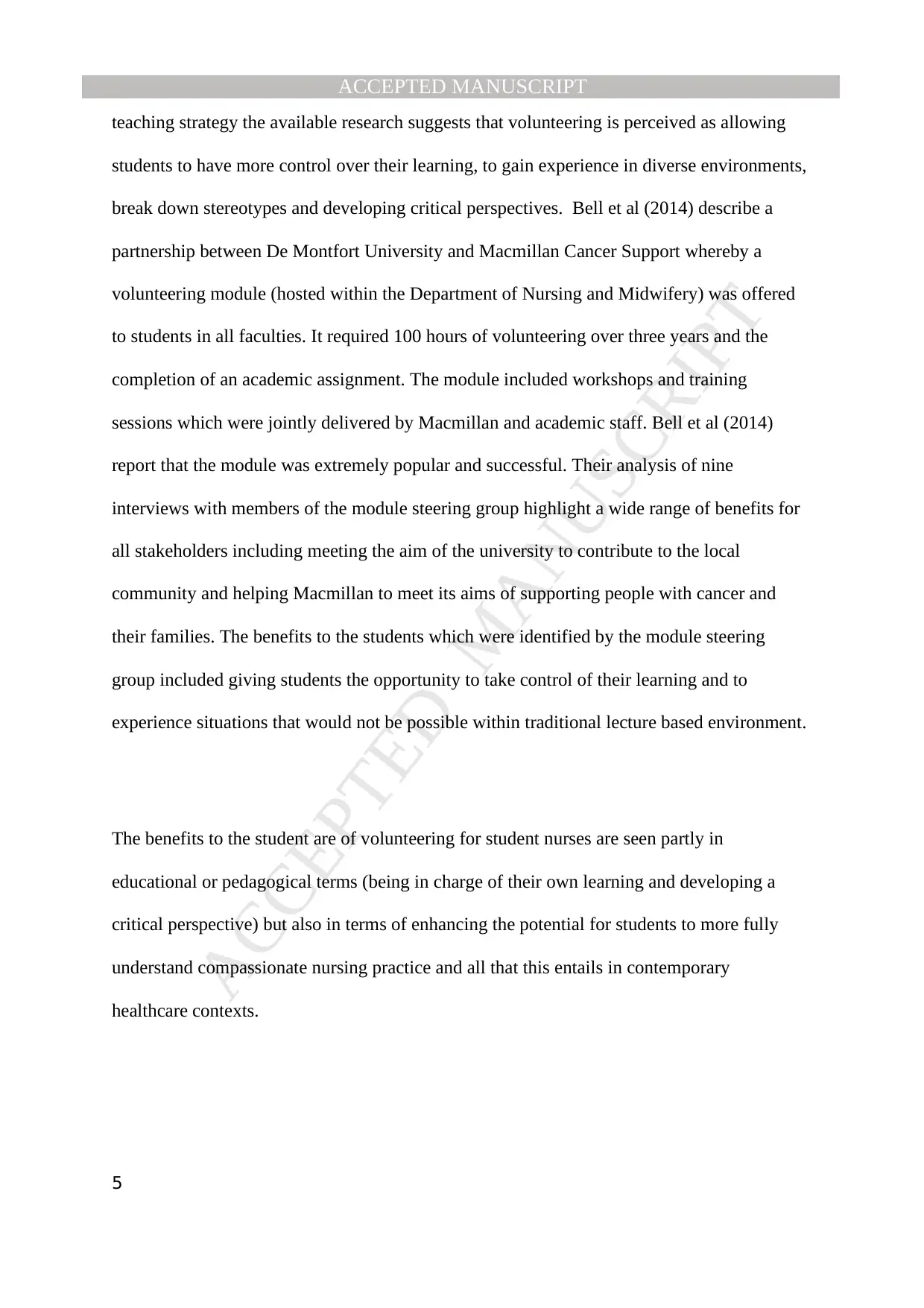
MANUSCRIPTACCEPTED
ACCEPTED MANUSCRIPT
5
teaching strategy the available research suggests that volunteering is perceived as allowing
students to have more control over their learning, to gain experience in diverse environments,
break down stereotypes and developing critical perspectives. Bell et al (2014) describe a
partnership between De Montfort University and Macmillan Cancer Support whereby a
volunteering module (hosted within the Department of Nursing and Midwifery) was offered
to students in all faculties. It required 100 hours of volunteering over three years and the
completion of an academic assignment. The module included workshops and training
sessions which were jointly delivered by Macmillan and academic staff. Bell et al (2014)
report that the module was extremely popular and successful. Their analysis of nine
interviews with members of the module steering group highlight a wide range of benefits for
all stakeholders including meeting the aim of the university to contribute to the local
community and helping Macmillan to meet its aims of supporting people with cancer and
their families. The benefits to the students which were identified by the module steering
group included giving students the opportunity to take control of their learning and to
experience situations that would not be possible within traditional lecture based environment.
The benefits to the student are of volunteering for student nurses are seen partly in
educational or pedagogical terms (being in charge of their own learning and developing a
critical perspective) but also in terms of enhancing the potential for students to more fully
understand compassionate nursing practice and all that this entails in contemporary
healthcare contexts.
ACCEPTED MANUSCRIPT
5
teaching strategy the available research suggests that volunteering is perceived as allowing
students to have more control over their learning, to gain experience in diverse environments,
break down stereotypes and developing critical perspectives. Bell et al (2014) describe a
partnership between De Montfort University and Macmillan Cancer Support whereby a
volunteering module (hosted within the Department of Nursing and Midwifery) was offered
to students in all faculties. It required 100 hours of volunteering over three years and the
completion of an academic assignment. The module included workshops and training
sessions which were jointly delivered by Macmillan and academic staff. Bell et al (2014)
report that the module was extremely popular and successful. Their analysis of nine
interviews with members of the module steering group highlight a wide range of benefits for
all stakeholders including meeting the aim of the university to contribute to the local
community and helping Macmillan to meet its aims of supporting people with cancer and
their families. The benefits to the students which were identified by the module steering
group included giving students the opportunity to take control of their learning and to
experience situations that would not be possible within traditional lecture based environment.
The benefits to the student are of volunteering for student nurses are seen partly in
educational or pedagogical terms (being in charge of their own learning and developing a
critical perspective) but also in terms of enhancing the potential for students to more fully
understand compassionate nursing practice and all that this entails in contemporary
healthcare contexts.
⊘ This is a preview!⊘
Do you want full access?
Subscribe today to unlock all pages.

Trusted by 1+ million students worldwide
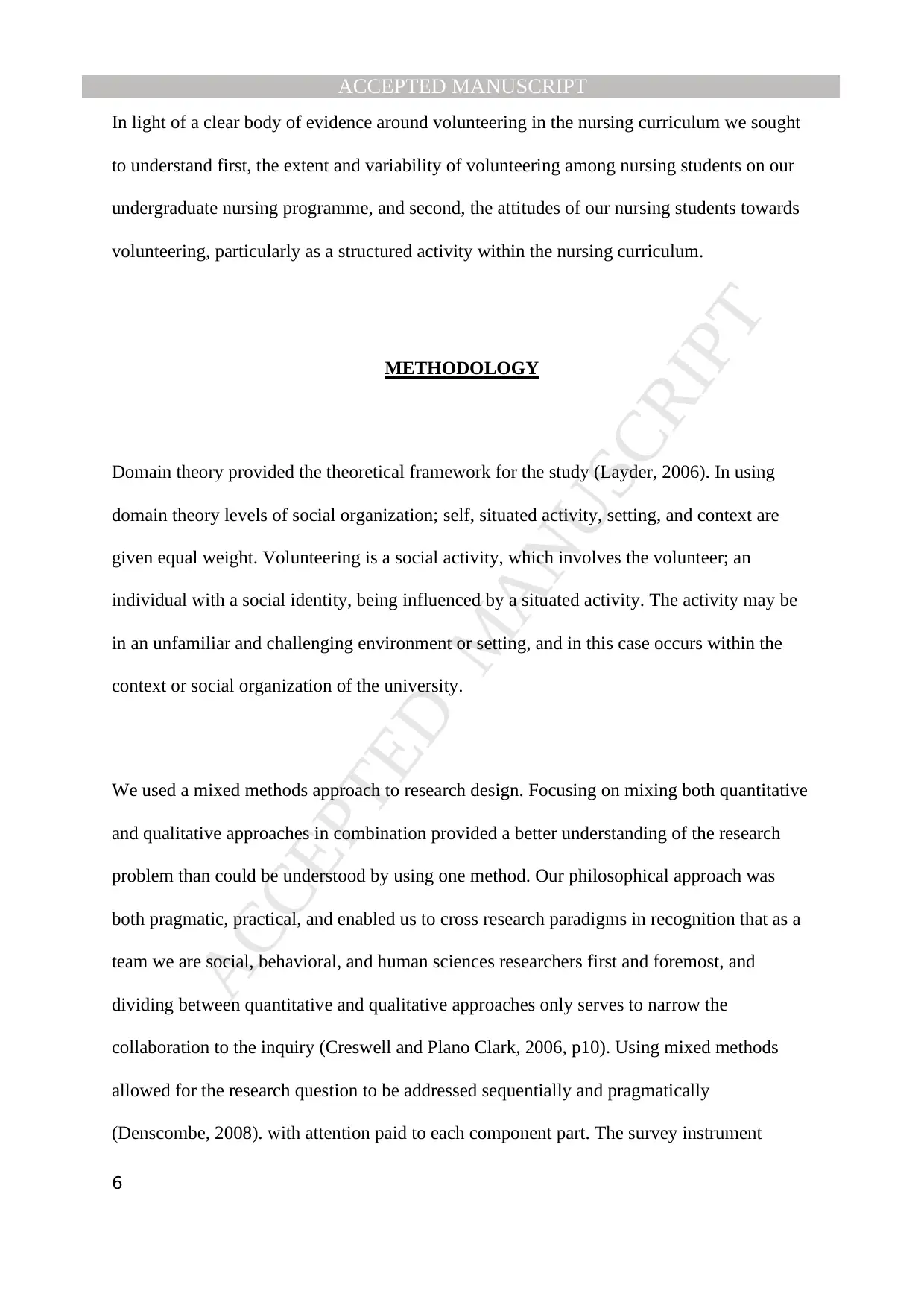
MANUSCRIPTACCEPTED
ACCEPTED MANUSCRIPT
6
In light of a clear body of evidence around volunteering in the nursing curriculum we sought
to understand first, the extent and variability of volunteering among nursing students on our
undergraduate nursing programme, and second, the attitudes of our nursing students towards
volunteering, particularly as a structured activity within the nursing curriculum.
METHODOLOGY
Domain theory provided the theoretical framework for the study (Layder, 2006). In using
domain theory levels of social organization; self, situated activity, setting, and context are
given equal weight. Volunteering is a social activity, which involves the volunteer; an
individual with a social identity, being influenced by a situated activity. The activity may be
in an unfamiliar and challenging environment or setting, and in this case occurs within the
context or social organization of the university.
We used a mixed methods approach to research design. Focusing on mixing both quantitative
and qualitative approaches in combination provided a better understanding of the research
problem than could be understood by using one method. Our philosophical approach was
both pragmatic, practical, and enabled us to cross research paradigms in recognition that as a
team we are social, behavioral, and human sciences researchers first and foremost, and
dividing between quantitative and qualitative approaches only serves to narrow the
collaboration to the inquiry (Creswell and Plano Clark, 2006, p10). Using mixed methods
allowed for the research question to be addressed sequentially and pragmatically
(Denscombe, 2008). with attention paid to each component part. The survey instrument
ACCEPTED MANUSCRIPT
6
In light of a clear body of evidence around volunteering in the nursing curriculum we sought
to understand first, the extent and variability of volunteering among nursing students on our
undergraduate nursing programme, and second, the attitudes of our nursing students towards
volunteering, particularly as a structured activity within the nursing curriculum.
METHODOLOGY
Domain theory provided the theoretical framework for the study (Layder, 2006). In using
domain theory levels of social organization; self, situated activity, setting, and context are
given equal weight. Volunteering is a social activity, which involves the volunteer; an
individual with a social identity, being influenced by a situated activity. The activity may be
in an unfamiliar and challenging environment or setting, and in this case occurs within the
context or social organization of the university.
We used a mixed methods approach to research design. Focusing on mixing both quantitative
and qualitative approaches in combination provided a better understanding of the research
problem than could be understood by using one method. Our philosophical approach was
both pragmatic, practical, and enabled us to cross research paradigms in recognition that as a
team we are social, behavioral, and human sciences researchers first and foremost, and
dividing between quantitative and qualitative approaches only serves to narrow the
collaboration to the inquiry (Creswell and Plano Clark, 2006, p10). Using mixed methods
allowed for the research question to be addressed sequentially and pragmatically
(Denscombe, 2008). with attention paid to each component part. The survey instrument
Paraphrase This Document
Need a fresh take? Get an instant paraphrase of this document with our AI Paraphraser
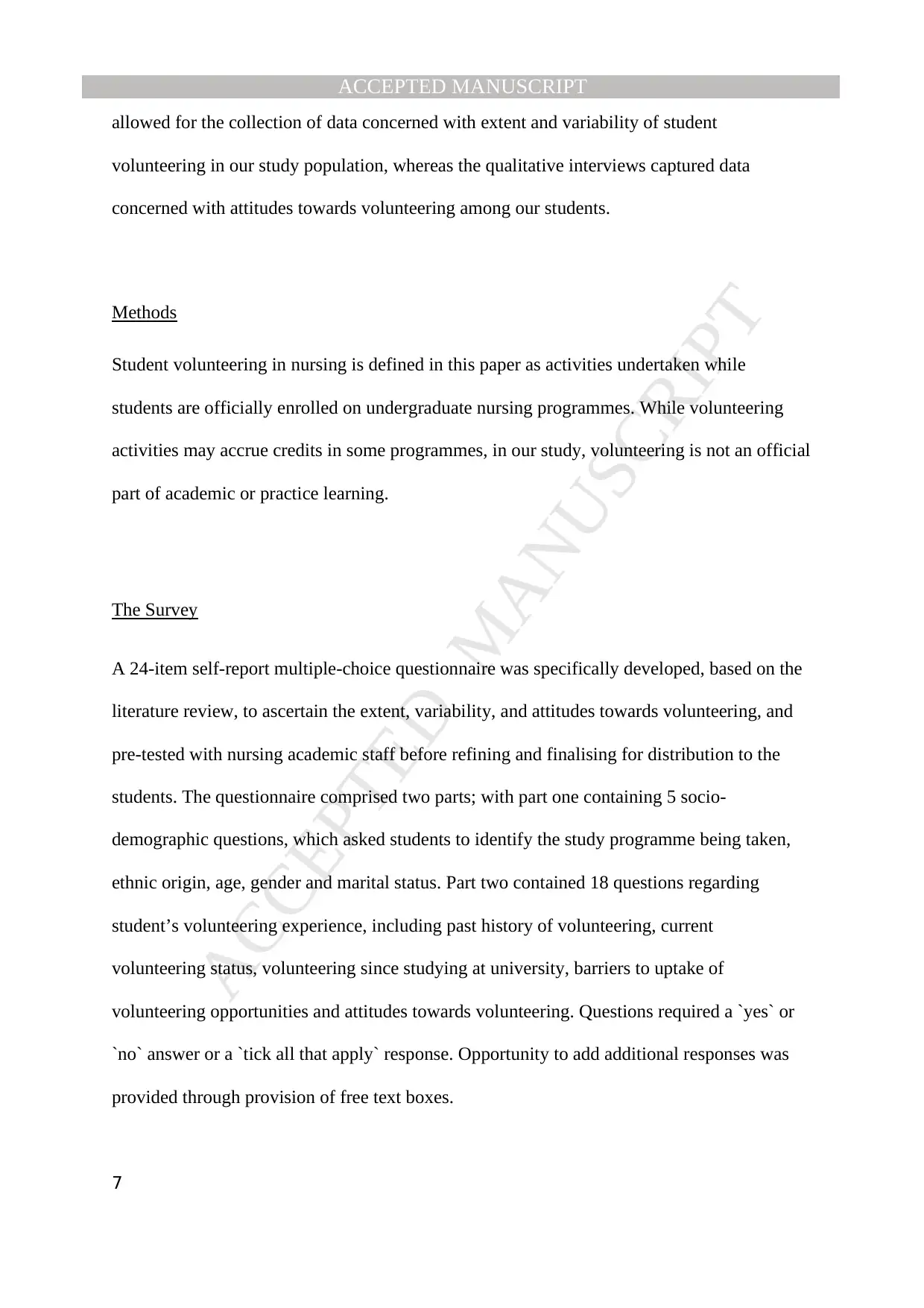
MANUSCRIPTACCEPTED
ACCEPTED MANUSCRIPT
7
allowed for the collection of data concerned with extent and variability of student
volunteering in our study population, whereas the qualitative interviews captured data
concerned with attitudes towards volunteering among our students.
Methods
Student volunteering in nursing is defined in this paper as activities undertaken while
students are officially enrolled on undergraduate nursing programmes. While volunteering
activities may accrue credits in some programmes, in our study, volunteering is not an official
part of academic or practice learning.
The Survey
A 24-item self-report multiple-choice questionnaire was specifically developed, based on the
literature review, to ascertain the extent, variability, and attitudes towards volunteering, and
pre-tested with nursing academic staff before refining and finalising for distribution to the
students. The questionnaire comprised two parts; with part one containing 5 socio-
demographic questions, which asked students to identify the study programme being taken,
ethnic origin, age, gender and marital status. Part two contained 18 questions regarding
student’s volunteering experience, including past history of volunteering, current
volunteering status, volunteering since studying at university, barriers to uptake of
volunteering opportunities and attitudes towards volunteering. Questions required a `yes` or
`no` answer or a `tick all that apply` response. Opportunity to add additional responses was
provided through provision of free text boxes.
ACCEPTED MANUSCRIPT
7
allowed for the collection of data concerned with extent and variability of student
volunteering in our study population, whereas the qualitative interviews captured data
concerned with attitudes towards volunteering among our students.
Methods
Student volunteering in nursing is defined in this paper as activities undertaken while
students are officially enrolled on undergraduate nursing programmes. While volunteering
activities may accrue credits in some programmes, in our study, volunteering is not an official
part of academic or practice learning.
The Survey
A 24-item self-report multiple-choice questionnaire was specifically developed, based on the
literature review, to ascertain the extent, variability, and attitudes towards volunteering, and
pre-tested with nursing academic staff before refining and finalising for distribution to the
students. The questionnaire comprised two parts; with part one containing 5 socio-
demographic questions, which asked students to identify the study programme being taken,
ethnic origin, age, gender and marital status. Part two contained 18 questions regarding
student’s volunteering experience, including past history of volunteering, current
volunteering status, volunteering since studying at university, barriers to uptake of
volunteering opportunities and attitudes towards volunteering. Questions required a `yes` or
`no` answer or a `tick all that apply` response. Opportunity to add additional responses was
provided through provision of free text boxes.
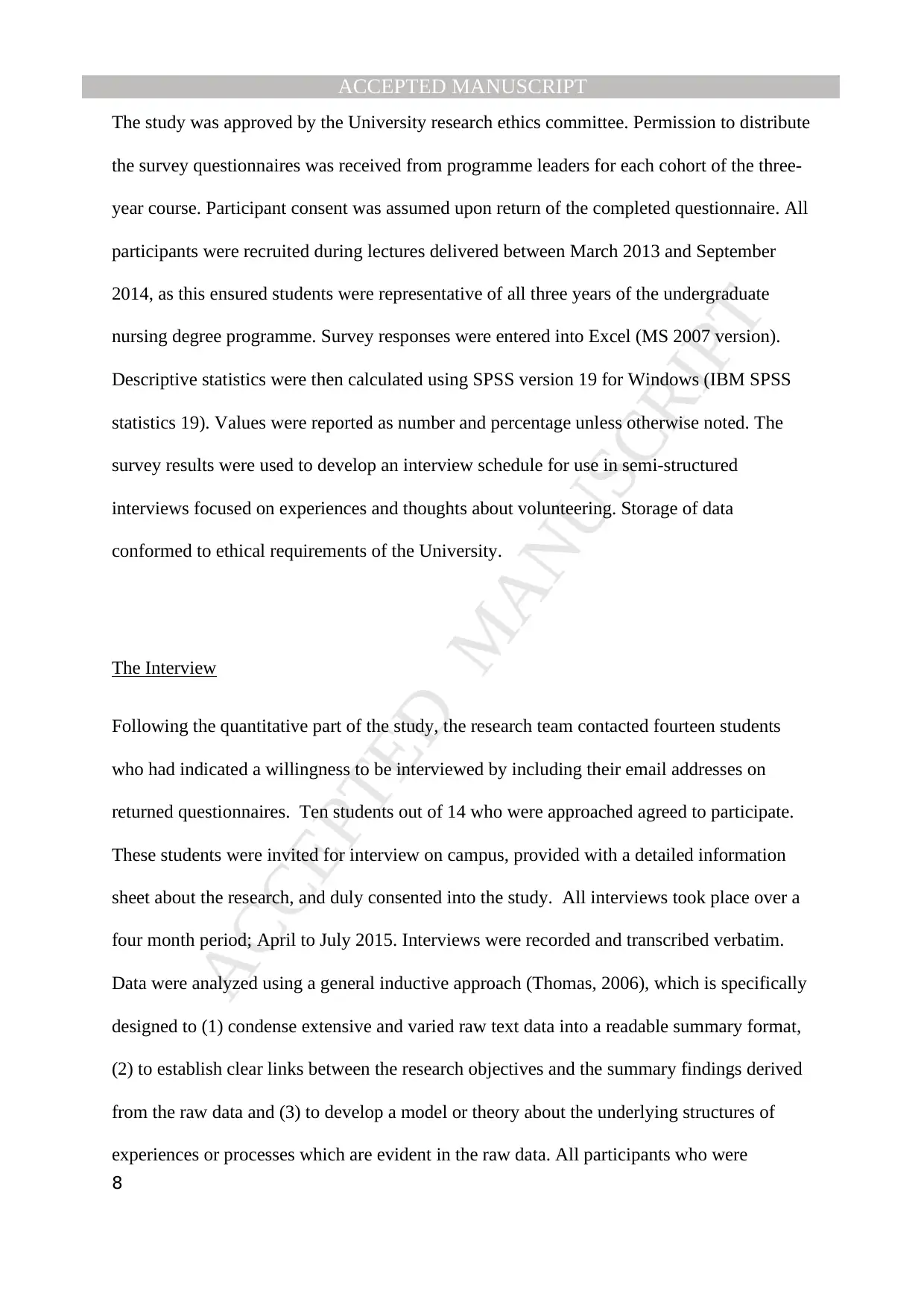
MANUSCRIPTACCEPTED
ACCEPTED MANUSCRIPT
8
The study was approved by the University research ethics committee. Permission to distribute
the survey questionnaires was received from programme leaders for each cohort of the three-
year course. Participant consent was assumed upon return of the completed questionnaire. All
participants were recruited during lectures delivered between March 2013 and September
2014, as this ensured students were representative of all three years of the undergraduate
nursing degree programme. Survey responses were entered into Excel (MS 2007 version).
Descriptive statistics were then calculated using SPSS version 19 for Windows (IBM SPSS
statistics 19). Values were reported as number and percentage unless otherwise noted. The
survey results were used to develop an interview schedule for use in semi-structured
interviews focused on experiences and thoughts about volunteering. Storage of data
conformed to ethical requirements of the University.
The Interview
Following the quantitative part of the study, the research team contacted fourteen students
who had indicated a willingness to be interviewed by including their email addresses on
returned questionnaires. Ten students out of 14 who were approached agreed to participate.
These students were invited for interview on campus, provided with a detailed information
sheet about the research, and duly consented into the study. All interviews took place over a
four month period; April to July 2015. Interviews were recorded and transcribed verbatim.
Data were analyzed using a general inductive approach (Thomas, 2006), which is specifically
designed to (1) condense extensive and varied raw text data into a readable summary format,
(2) to establish clear links between the research objectives and the summary findings derived
from the raw data and (3) to develop a model or theory about the underlying structures of
experiences or processes which are evident in the raw data. All participants who were
ACCEPTED MANUSCRIPT
8
The study was approved by the University research ethics committee. Permission to distribute
the survey questionnaires was received from programme leaders for each cohort of the three-
year course. Participant consent was assumed upon return of the completed questionnaire. All
participants were recruited during lectures delivered between March 2013 and September
2014, as this ensured students were representative of all three years of the undergraduate
nursing degree programme. Survey responses were entered into Excel (MS 2007 version).
Descriptive statistics were then calculated using SPSS version 19 for Windows (IBM SPSS
statistics 19). Values were reported as number and percentage unless otherwise noted. The
survey results were used to develop an interview schedule for use in semi-structured
interviews focused on experiences and thoughts about volunteering. Storage of data
conformed to ethical requirements of the University.
The Interview
Following the quantitative part of the study, the research team contacted fourteen students
who had indicated a willingness to be interviewed by including their email addresses on
returned questionnaires. Ten students out of 14 who were approached agreed to participate.
These students were invited for interview on campus, provided with a detailed information
sheet about the research, and duly consented into the study. All interviews took place over a
four month period; April to July 2015. Interviews were recorded and transcribed verbatim.
Data were analyzed using a general inductive approach (Thomas, 2006), which is specifically
designed to (1) condense extensive and varied raw text data into a readable summary format,
(2) to establish clear links between the research objectives and the summary findings derived
from the raw data and (3) to develop a model or theory about the underlying structures of
experiences or processes which are evident in the raw data. All participants who were
⊘ This is a preview!⊘
Do you want full access?
Subscribe today to unlock all pages.

Trusted by 1+ million students worldwide
1 out of 39
Your All-in-One AI-Powered Toolkit for Academic Success.
+13062052269
info@desklib.com
Available 24*7 on WhatsApp / Email
![[object Object]](/_next/static/media/star-bottom.7253800d.svg)
Unlock your academic potential
Copyright © 2020–2025 A2Z Services. All Rights Reserved. Developed and managed by ZUCOL.